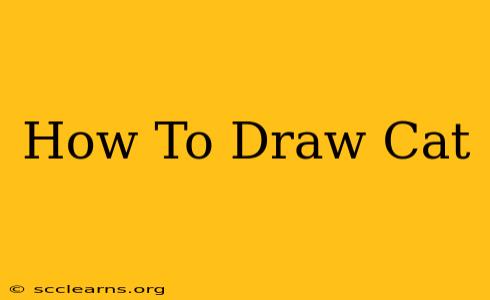Drawing a cat can seem daunting, but with a little patience and these simple steps, you'll be creating adorable feline friends in no time! This guide is perfect for beginners, focusing on basic shapes and techniques to build a charming cat drawing. Let's get started!
Gathering Your Supplies
Before we begin our artistic journey, let's make sure we have everything we need. You won't need expensive art supplies; a simple setup will work perfectly. Here's what you'll need:
- Paper: Any paper will do, but thicker paper is preferable to prevent smudging. Sketch paper or drawing paper works great.
- Pencil: A standard HB pencil is ideal for sketching. You can use a softer pencil (like a 2B) for shading later.
- Eraser: A good quality eraser is crucial for correcting mistakes.
- Sharpener: Keep your pencil sharp for precise lines.
- Optional: Colored pencils, markers, or crayons for adding color to your finished drawing.
Step-by-Step Cat Drawing Instructions
Let's break down the process into manageable steps:
1. Sketching the Basic Shapes
Start with simple shapes to form the foundation of your cat. Think of circles and ovals:
- Head: Draw a circle for the head.
- Body: Add an oval connected to the circle for the body.
- Legs: Four small ovals or cylinders for the legs.
Don't worry about perfection at this stage; these are just guidelines.
2. Refining the Shape
Now, let's refine those initial shapes to create a more cat-like form:
- Connect the Head and Body: Smooth out the connection between the head and body circles/ovals.
- Tail: Add a curved line for the tail extending from the body.
- Ears: Draw two triangles on top of the head for the ears. Experiment with different ear shapes for variation.
3. Adding the Facial Features
It's time to bring your cat to life with some expressive features:
- Eyes: Draw two almond-shaped eyes inside the head, slightly slanted.
- Nose: Add a small triangle or upside-down heart shape for the nose.
- Mouth: A simple curved line creates a charming mouth. Experiment with different expressions!
4. Detailing the Fur
Let's give our cat some furry texture:
- Whiskers: Add several short lines extending from the sides of the nose for whiskers.
- Fur Texture: Use light strokes to suggest fur around the body, tail, and paws. Short, light strokes work well for shorter fur.
5. Adding the Paws
Finally, let's give our cat some paws:
- Paw Shapes: Add small oval shapes at the end of each leg for the paws.
- Claws (Optional): You can add tiny triangles to suggest claws if you like.
6. Erase Guidelines
Gently erase the initial guideline circles and ovals to reveal your finished cat drawing.
Tips for Drawing Different Cat Breeds
Once you've mastered the basics, you can try drawing different cat breeds by modifying the shapes and features:
- Siamese Cats: Siamese cats have distinctive pointed features; emphasize the ears and face shape.
- Persian Cats: Persian cats have long, fluffy fur, so emphasize the fullness of the fur in your drawing.
- Tabby Cats: Tabby cats have striped fur, so add stripes to your cat drawing.
Practice Makes Perfect!
The key to improving your cat-drawing skills is practice! Try drawing different poses, expressions, and breeds. Don't be afraid to experiment. The more you draw, the better you'll become. Have fun and enjoy the creative process!
Keywords: how to draw a cat, draw a cat, cat drawing, drawing tutorial, easy cat drawing, beginner cat drawing, step-by-step cat drawing, how to draw cat step by step, cat drawing tutorial for beginners, draw a cartoon cat, cute cat drawing, realistic cat drawing, different cat breeds, cat anatomy for drawing.

